Autumn calving is nearly finished, with just seven cows left to calve out of 39 in total. So far, we have 31 live calves from 32 cows calved. These include two sets of twins.
We have lost three calves so far. The first of those was a cow that slipped a calf a few weeks prior to her due date. Of the other two, one was a difficult calving and the other died at a couple of days of age.
Calving started outside in late September but we had a TB test the last week of October and with the weather turning, we decided to keep the cows in at that stage.
Thankfully the herd had a clear TB test. A creep area for the calves has been created at the back of the straw-bedded court to allow them to get away from the cows and have a comfortable dry lie.
Scanning
Pregnancy-scanning the cows is always a nervous day on the farm. The success or failure of the following year can somewhat hinge on that one day’s results.
Last year, we had a poor scan on the spring cows as one of the bulls was sub-fertile and left too many cows not in-calf. This added to the pressure this year.
In total, out of 52 cows to the bull, 50 scanned in calf – a 96% in-calf rate
Thankfully, once the first few cows had gone through the race and were positively identified as being in-calf, the pressure subsided.
In total, out of 52 cows to the bull, 50 scanned in calf – a 96% in-calf rate.
Within this there are two sub-groups. The in-bye spring calving herd of 40 cows of which the two empty cows were part of, while the other group was the first-calved Shorthorn cross heifers who are all in-calf.
Calving spread
The bulls were with the cows for just 12 weeks, so we should have a nice tight calving spread on this herd next year, with almost 83% of the cows scanned to calve in the first eight weeks or 92% in the first 10 weeks.
Looking at Figure 1, it is clear to see that we could tighten this calving further in the coming years as there are just a couple of stragglers.
As we continue to improve the nutrition and body condition management of the herd, we can get down to a nine-week or less calving spread.
Weaning weights
We weaned 40 spring-born calves at housing. To see how each bull is performing on farm, we have compared the daily liveweight gains of each sire. From the mature cows, the Simmental bull had the best liveweight gain at 1.09kg/hd/day.
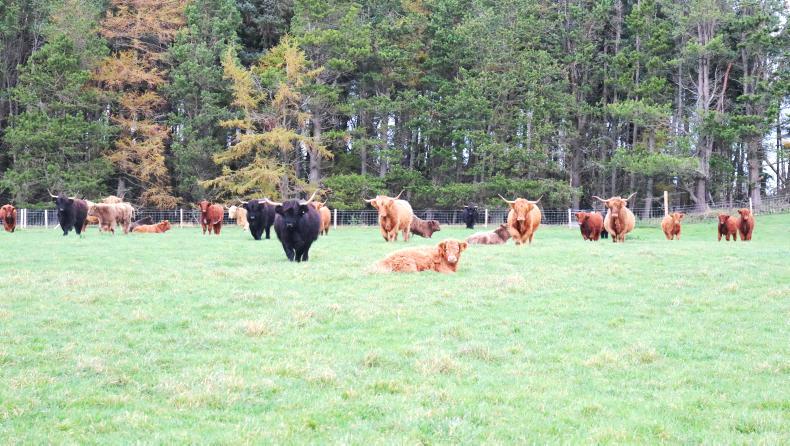
Highland cows and calves at Duffus' farm Tomintoul.
This was followed closely by the Charolais at 1.07kg/hd/day. The Limousin bull’s calves achieved 0.99kg/hd/day. However, this included some first-calved heifers’ calves.
It is only by measuring performance and using this information to make decisions going forward that we can hope to improve the herd genetics and performance.
The Shorthorn calves off the Shorthorn cross Highlander first-calved heifers achieved a daily liveweight gain of 0.82kg/hd/day. This is very respectable give that they are first calvers and spent all summer on the hill ground.
This is ground that would be producing little else all year had they not been grazing it.
These calves were on average 203kg at 218 days old
One thing we are not short of here is hill acres and there is massive potential to increase the output from the hill while at the same time improving the grazing quality of the natural hill grasses.
These calves were on average 203kg at 218 days old. Their mothers, however, are an average weight of just 467kg, meaning they weaned 43% of their body weight and they are all back in-calf again for next year – we are more than pleased with that.
Highlanders
The rest of the hill cows, comprising mainly Highland cows, calved in May and will be weaned in a few weeks’ time. We have just bought another six Shorthorn cross Highlander cows with calves at foot.
They have cost us just shy of £1,000/hd and are scanned back in-calf again to a Shorthorn bull. This will boost the hill cow numbers for next year.
Store sales
We sold the first batch of 2018-born autumn steers two weeks ago at Thainstone. In total, 17 were sold at an average weight of 469kg and made £967/hd on average or 2.08/kg.
Given where the beef trade is at the moment, we were quite happy with how we got on.
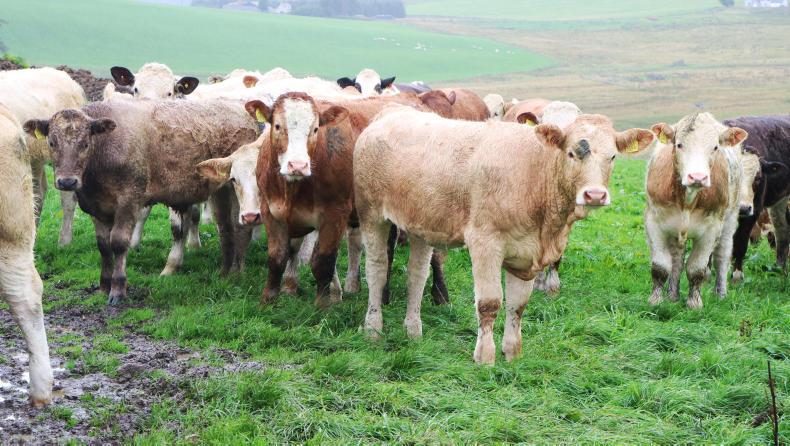
Autumn stores prior to sale.
Although the price per kilo is back on last year, thankfully our sale weights were up quite significantly on the year – almost 25kg – which meant on a per-head basis we are about the same as last year.
Hopefully we can maintain the sale weights in the future and if the beef price can recover we will be in a much better place.
The average birthdate of this batch was late October, so they were just gone 12 months old at the time of sale.
Lifetime gain on the farm was 1.16kg/hd/day. Valued at £2.08/kg, that’s a daily gain worth £2.41/kg liveweight. We have the remainder of the autumn calves to sell in a few weeks’ time.
We are trying to maximise sale weights to make up for the poorer beef price this year.
Sheep
Ewe numbers are being maintained for next year at around 550 ewes. The tups will be going out in late November to give us a late April lambing date.
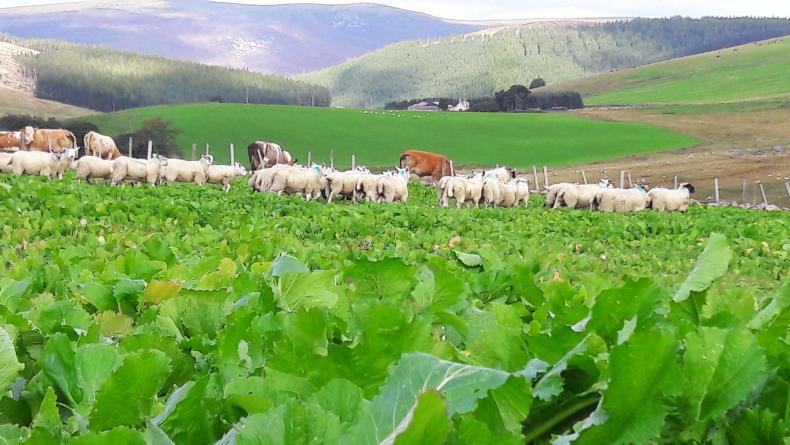
Finishing lambs on Skyfall - a leafy stubble turnip.
We have retained most of the lambs this year for finishing.
Usually we sell a lot as stores in September, but as we are trying to add value to the sheep and improve our gross margin the decision was taken to finish more lambs on farm.
Forage crops
Once September comes, grass soon disappears here in the hills. With this in mind, this year we planted 7ac of Skyfall, a leafy stubble turnip and 7ac of regular stubble turnips for finishing lambs.
We were attracted to the Skyfall as it had the ability to regrow and offer us a number of grazings throughout autumn and into early winter.
Both crops were direct-drilled in to a sprayed-off grass ley. Establishment was very good in both cases.
We have managed to get three or four grazings off the Skyfall before moving to the stubble turnips.
However, performance on the crop has not been as good as we would have expected.
In hindsight, we maybe could have introduced barley hoppers at an earlier stage to boost the energy of the diet
We drafted lambs on to the Skyfall at around 37-38kg with the hopes that we would be drafting them for slaughter from this in a few weeks’ time.
The lighter lambs that remained on grass aftermaths seemed to thrive every bit as well if not better than those on Skyfall.
In saying this, the lambs were much cleaner on the Skyfall, which made drafting much easier.
In hindsight, we maybe could have introduced barley hoppers at an earlier stage to boost the energy of the diet.
At this stage, we don’t think it is something we would do again. Instead we will concentrate on building a bank of grass in late summer and early autumn to carry the lambs through to slaughter.
The regular stubble turnips are being grazed at the moment with the last of the finishing lambs. Whatever they do not eat will be cleaned up with dry cows later in winter.
Autumn calving is nearly finished, with just seven cows left to calve out of 39 in total. So far, we have 31 live calves from 32 cows calved. These include two sets of twins.
We have lost three calves so far. The first of those was a cow that slipped a calf a few weeks prior to her due date. Of the other two, one was a difficult calving and the other died at a couple of days of age.
Calving started outside in late September but we had a TB test the last week of October and with the weather turning, we decided to keep the cows in at that stage.
Thankfully the herd had a clear TB test. A creep area for the calves has been created at the back of the straw-bedded court to allow them to get away from the cows and have a comfortable dry lie.
Scanning
Pregnancy-scanning the cows is always a nervous day on the farm. The success or failure of the following year can somewhat hinge on that one day’s results.
Last year, we had a poor scan on the spring cows as one of the bulls was sub-fertile and left too many cows not in-calf. This added to the pressure this year.
In total, out of 52 cows to the bull, 50 scanned in calf – a 96% in-calf rate
Thankfully, once the first few cows had gone through the race and were positively identified as being in-calf, the pressure subsided.
In total, out of 52 cows to the bull, 50 scanned in calf – a 96% in-calf rate.
Within this there are two sub-groups. The in-bye spring calving herd of 40 cows of which the two empty cows were part of, while the other group was the first-calved Shorthorn cross heifers who are all in-calf.
Calving spread
The bulls were with the cows for just 12 weeks, so we should have a nice tight calving spread on this herd next year, with almost 83% of the cows scanned to calve in the first eight weeks or 92% in the first 10 weeks.
Looking at Figure 1, it is clear to see that we could tighten this calving further in the coming years as there are just a couple of stragglers.
As we continue to improve the nutrition and body condition management of the herd, we can get down to a nine-week or less calving spread.
Weaning weights
We weaned 40 spring-born calves at housing. To see how each bull is performing on farm, we have compared the daily liveweight gains of each sire. From the mature cows, the Simmental bull had the best liveweight gain at 1.09kg/hd/day.

Highland cows and calves at Duffus' farm Tomintoul.
This was followed closely by the Charolais at 1.07kg/hd/day. The Limousin bull’s calves achieved 0.99kg/hd/day. However, this included some first-calved heifers’ calves.
It is only by measuring performance and using this information to make decisions going forward that we can hope to improve the herd genetics and performance.
The Shorthorn calves off the Shorthorn cross Highlander first-calved heifers achieved a daily liveweight gain of 0.82kg/hd/day. This is very respectable give that they are first calvers and spent all summer on the hill ground.
This is ground that would be producing little else all year had they not been grazing it.
These calves were on average 203kg at 218 days old
One thing we are not short of here is hill acres and there is massive potential to increase the output from the hill while at the same time improving the grazing quality of the natural hill grasses.
These calves were on average 203kg at 218 days old. Their mothers, however, are an average weight of just 467kg, meaning they weaned 43% of their body weight and they are all back in-calf again for next year – we are more than pleased with that.
Highlanders
The rest of the hill cows, comprising mainly Highland cows, calved in May and will be weaned in a few weeks’ time. We have just bought another six Shorthorn cross Highlander cows with calves at foot.
They have cost us just shy of £1,000/hd and are scanned back in-calf again to a Shorthorn bull. This will boost the hill cow numbers for next year.
Store sales
We sold the first batch of 2018-born autumn steers two weeks ago at Thainstone. In total, 17 were sold at an average weight of 469kg and made £967/hd on average or 2.08/kg.
Given where the beef trade is at the moment, we were quite happy with how we got on.

Autumn stores prior to sale.
Although the price per kilo is back on last year, thankfully our sale weights were up quite significantly on the year – almost 25kg – which meant on a per-head basis we are about the same as last year.
Hopefully we can maintain the sale weights in the future and if the beef price can recover we will be in a much better place.
The average birthdate of this batch was late October, so they were just gone 12 months old at the time of sale.
Lifetime gain on the farm was 1.16kg/hd/day. Valued at £2.08/kg, that’s a daily gain worth £2.41/kg liveweight. We have the remainder of the autumn calves to sell in a few weeks’ time.
We are trying to maximise sale weights to make up for the poorer beef price this year.
Sheep
Ewe numbers are being maintained for next year at around 550 ewes. The tups will be going out in late November to give us a late April lambing date.

Finishing lambs on Skyfall - a leafy stubble turnip.
We have retained most of the lambs this year for finishing.
Usually we sell a lot as stores in September, but as we are trying to add value to the sheep and improve our gross margin the decision was taken to finish more lambs on farm.
Forage crops
Once September comes, grass soon disappears here in the hills. With this in mind, this year we planted 7ac of Skyfall, a leafy stubble turnip and 7ac of regular stubble turnips for finishing lambs.
We were attracted to the Skyfall as it had the ability to regrow and offer us a number of grazings throughout autumn and into early winter.
Both crops were direct-drilled in to a sprayed-off grass ley. Establishment was very good in both cases.
We have managed to get three or four grazings off the Skyfall before moving to the stubble turnips.
However, performance on the crop has not been as good as we would have expected.
In hindsight, we maybe could have introduced barley hoppers at an earlier stage to boost the energy of the diet
We drafted lambs on to the Skyfall at around 37-38kg with the hopes that we would be drafting them for slaughter from this in a few weeks’ time.
The lighter lambs that remained on grass aftermaths seemed to thrive every bit as well if not better than those on Skyfall.
In saying this, the lambs were much cleaner on the Skyfall, which made drafting much easier.
In hindsight, we maybe could have introduced barley hoppers at an earlier stage to boost the energy of the diet.
At this stage, we don’t think it is something we would do again. Instead we will concentrate on building a bank of grass in late summer and early autumn to carry the lambs through to slaughter.
The regular stubble turnips are being grazed at the moment with the last of the finishing lambs. Whatever they do not eat will be cleaned up with dry cows later in winter.









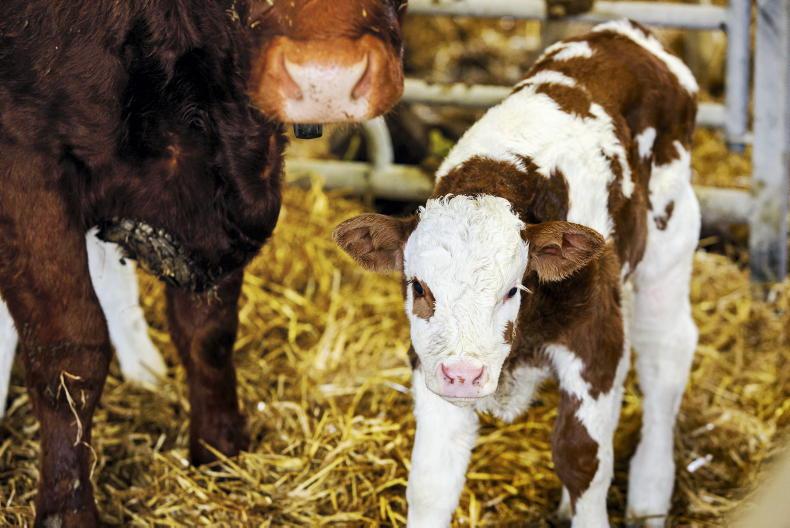
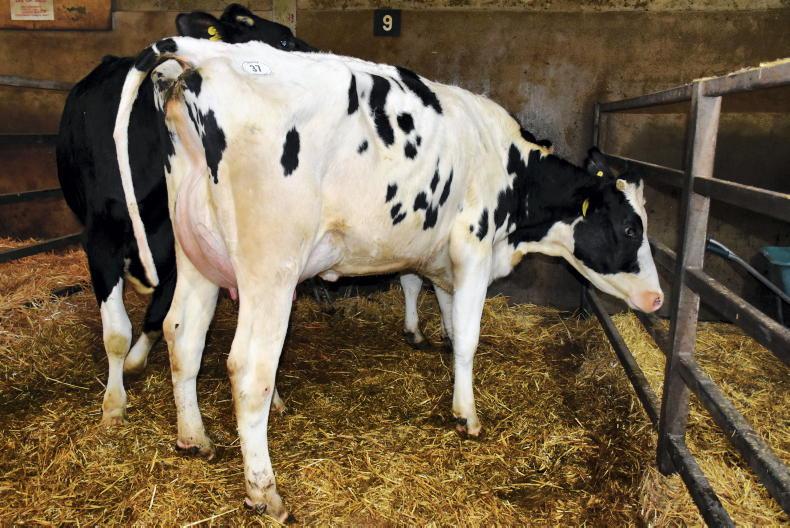
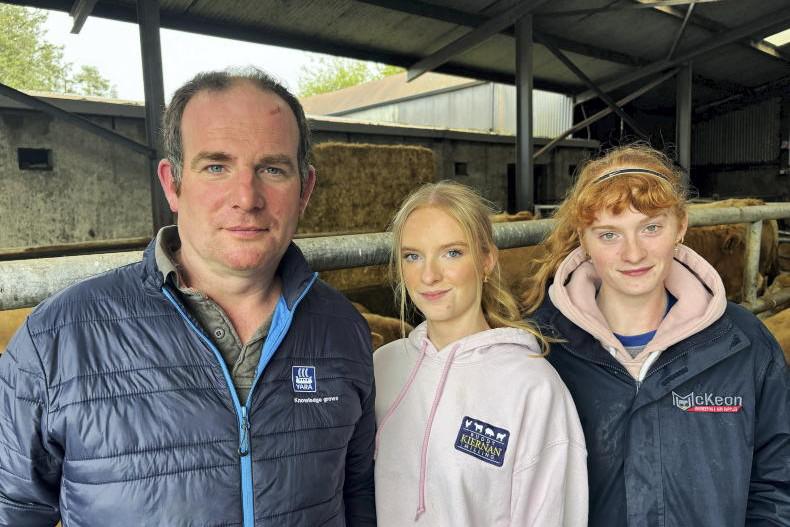
SHARING OPTIONS